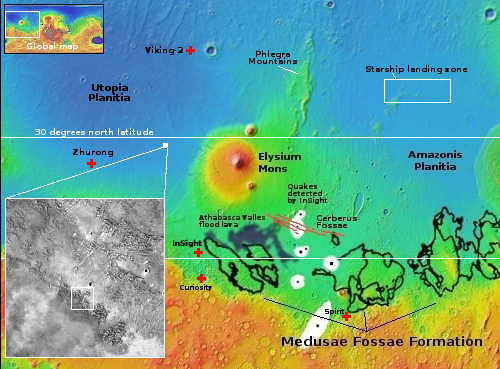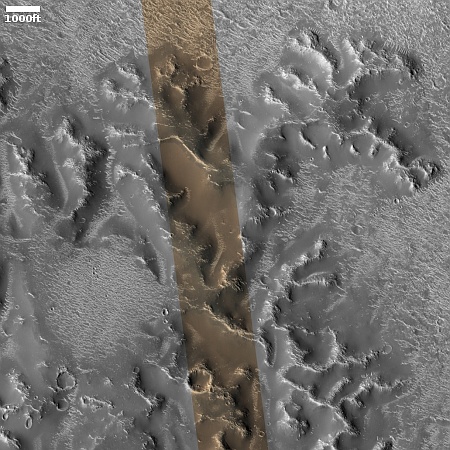Martian ridges that imitate rivers
Cool image time! The picture to the right, cropped, reduced, and sharpened to post here, was taken on February 26, 2025 by the high resolution camera on Mars Reconnaissance Orbiter (MRO).
The scientists describe these features as “dendritic relief features,” an apt description of the thousands of miles of river-like meandering ridges that orbital images have discovered in the past decade scattered across Mars, as noted in 2016:
The inverted channels are similar to those found elsewhere on Mars and Earth. They are made of sand and gravel deposited by a river and when the river becomes dry, the channels are left upstanding as the surrounding material erodes. On Earth, inverted channels often occur in dry, desert environments like Oman, Egypt, or Utah, where erosion rates are low – in most other environments, the channels are worn away before they can become inverted.
The most dramatic example of these Martian ridge rivers are the fernlike ridges in Antoniadi Crater. The ridges to the right however are almost as striking.

The white dot on the overview map to the right marks the location, inside the northern lowland plains but at 28 degrees north latitude just inside the dry equatorial region of Mars.
This particular bit of dentritic ridges happens to near the southernmost point of a large patch of such ridges, stretching more than 150 miles to the northwest. Apparently when this region had more water or near surface ice, this drainage produced these hardened channel beds, which resisted erosion when the surrounding landscape was worn away by wind and other processes.
Though the full image shows some signs that near surface ice might still exist here, these ridges suggest that most of the water is gone.
Once again it is important to note that though our Earthbound instincts insist these channels were formed by flowing liquid water, that does not have be the case. Glacial ice might have instead caused this, in a uniquely Martian manner.
At the moment we simply don’t know. Not enough data.
On Christmas Eve 1968 three Americans became the first humans to visit another world. What they did to celebrate was unexpected and profound, and will be remembered throughout all human history. Genesis: the Story of Apollo 8, Robert Zimmerman's classic history of humanity's first journey to another world, tells that story, and it is now available as both an ebook and an audiobook, both with a foreword by Valerie Anders and a new introduction by Robert Zimmerman.
The print edition can be purchased at Amazon or from any other book seller. If you want an autographed copy the price is $60 for the hardback and $45 for the paperback, plus $8 shipping for each. Go here for purchasing details. The ebook is available everywhere for $5.99 (before discount) at amazon, or direct from my ebook publisher, ebookit. If you buy it from ebookit you don't support the big tech companies and the author gets a bigger cut much sooner.
The audiobook is also available at all these vendors, and is also free with a 30-day trial membership to Audible.
"Not simply about one mission, [Genesis] is also the history of America's quest for the moon... Zimmerman has done a masterful job of tying disparate events together into a solid account of one of America's greatest human triumphs."--San Antonio Express-News
Cool image time! The picture to the right, cropped, reduced, and sharpened to post here, was taken on February 26, 2025 by the high resolution camera on Mars Reconnaissance Orbiter (MRO).
The scientists describe these features as “dendritic relief features,” an apt description of the thousands of miles of river-like meandering ridges that orbital images have discovered in the past decade scattered across Mars, as noted in 2016:
The inverted channels are similar to those found elsewhere on Mars and Earth. They are made of sand and gravel deposited by a river and when the river becomes dry, the channels are left upstanding as the surrounding material erodes. On Earth, inverted channels often occur in dry, desert environments like Oman, Egypt, or Utah, where erosion rates are low – in most other environments, the channels are worn away before they can become inverted.
The most dramatic example of these Martian ridge rivers are the fernlike ridges in Antoniadi Crater. The ridges to the right however are almost as striking.

The white dot on the overview map to the right marks the location, inside the northern lowland plains but at 28 degrees north latitude just inside the dry equatorial region of Mars.
This particular bit of dentritic ridges happens to near the southernmost point of a large patch of such ridges, stretching more than 150 miles to the northwest. Apparently when this region had more water or near surface ice, this drainage produced these hardened channel beds, which resisted erosion when the surrounding landscape was worn away by wind and other processes.
Though the full image shows some signs that near surface ice might still exist here, these ridges suggest that most of the water is gone.
Once again it is important to note that though our Earthbound instincts insist these channels were formed by flowing liquid water, that does not have be the case. Glacial ice might have instead caused this, in a uniquely Martian manner.
At the moment we simply don’t know. Not enough data.
On Christmas Eve 1968 three Americans became the first humans to visit another world. What they did to celebrate was unexpected and profound, and will be remembered throughout all human history. Genesis: the Story of Apollo 8, Robert Zimmerman's classic history of humanity's first journey to another world, tells that story, and it is now available as both an ebook and an audiobook, both with a foreword by Valerie Anders and a new introduction by Robert Zimmerman.
The print edition can be purchased at Amazon or from any other book seller. If you want an autographed copy the price is $60 for the hardback and $45 for the paperback, plus $8 shipping for each. Go here for purchasing details. The ebook is available everywhere for $5.99 (before discount) at amazon, or direct from my ebook publisher, ebookit. If you buy it from ebookit you don't support the big tech companies and the author gets a bigger cut much sooner.
The audiobook is also available at all these vendors, and is also free with a 30-day trial membership to Audible.
"Not simply about one mission, [Genesis] is also the history of America's quest for the moon... Zimmerman has done a masterful job of tying disparate events together into a solid account of one of America's greatest human triumphs."--San Antonio Express-News



It is interesting seeing far more impact craters on this site than some other recent posts… It would be interesting to see a studie regarding craters / age on the many fluid features on Mars… I actually agree with you once again Bob… Who knows how dust covered glaciers will act in Martian gravity, we all hold our fingers crossed for an age of liquid water, but Mars is alien, and we really need more data to understand the history of our neighbor.
NASA is the best in the world at this stuff… ESA is finally shooting Exo Mars soon.. I don’t want to jinx this mission, but I have been following it for…. 10, 15 years now.. no one will be more happy than me if it actually arrives and lands and deployes safely, I just have a bad feeling… I would have said the same if it was launched with the Russian lander platform..
NASA can nail this stuff… Is it outside the pail that EAS could have asked NASA for some help with the landing gear, and no doubt SpaceX for the launch… This is a mission I have watched for decades, I have no doubt the rover will probably work… And if so do some very important science… Let’s just see if it rolls off the lander…
The channels seem to flow towards the central point, a Mesa, which at the time may have been an impact crater as the low spot, which now becomes a high spot from erosion.